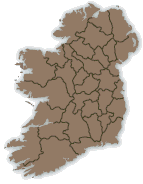Cogadh na ngaiscíoch (cuid 1) - Brian Mac Amhlaoibh
Recording: [Download audio file]
[Download AIFF audio file (of processed ‘user’ version)]
[Download AIFF audio file (of archive version)]
Transcript
Bhí deich[1] gaiscíoch[2] ar Caisleán Luirg Éadain. Chuaigh siad ar shiubhal lá amháin chun Sliabh Rush - Sliabh Luachair - ag seilg nuair a tháini'[3]... nuair a tháini' Leathduine chun an chúirt. Agus cha rabh a'n nduine astoigh ach bean Oisín. D'fhiosraigh sé daoithe cá rabh iad na fir. Dúirt sí go rabh iad ag seilg ar Sliabh Luachair.
"Mur mbeidh siad aige[4] mo chaisleánsa in Albain ag a dó dhe- a chlog amárach... dó dhe-... dó dhéag a chlog amárach brisfidh mise[5] iad."
Nuair a tháini' na fir 'na[6] bhaile[7] d'árs[8] sí dófa goidé a bhí sé a ráitigh[9]. Agus chu-... chuaigh siad amach agus bhí iad ar shiubhal... ar shiubhal ar barr na creige... ag cogain na... na hordóig... na hordóig, (...) na (hordóig).
Translation
There were ten warriors in Lurigethan castle. They went hunting one day on Slieverush when Leathduine came to visit. And there was no one in except Oisín's wife. He asked her where the men were. She said that they were hunting on Slieverush.
"If they are not at my castle in Scotland at twelve o'clock tomorrow I will destroy them."
When the men came home she told them what he had been saying. And they went out and they went to the top of the crag... [and Oisín was (?)] chewing his thumb. (...).
Footnotes
The d- is broad. Cf. Nils M. Holmer, On some relics of the Irish dialect spoken in the glens of Antrim (Uppsala and Leipzig, 1940), § 64, where it is slender. (Back)Leg. gaisceach? (Back)
Cf. Holmer, op. cit., § 91. (Back)
= ag. Cf. Art Hughes, 'Gaeilge Uladh', in Kim McCone et al., Stair na Gaeilge (Maigh Nuad, 1994), 611-60: 657. (Back)
Leg. misi? Cf. Holmer, op. cit., § 65. (Back)
= chun an. (Back)
For the pronunciation of ai in Antrim Irish see Holmer, op. cit., § 25. (Back)
= d’ársaigh. (Back)
= rá. Cf. Patrick S. Dinneen, Foclóir Gaedhilge agus Béarla (Dublin, 1927; repr. 1996), s.v. ráidhtigh. (Back)
Commentary
Parts 1 and 2 of this story represent a partially remembered version of a much greater narrative, which is known as 'Fionn and the Seven Warrior Bands of the Fianna'. See Róise Ní Bhaoill, Ulster Gaelic voices: bailiúchán Doegen 1931 (Belfast, 2010), 294-7. It describes how Fionn accomplishes a task or goes on a journey with the help of a series of characters with extraordinary abilities. This greater narrative itself is based on an international folktale, ATU 513A Six go through the whole world. See Hans Jorg Uther, The types of international folktales: a classification and bibliography (3 vols, Helsinki, 2004). It was present in Ireland since at least the tenth or early eleventh century. See Dáithí Ó hÓgáin, Myth, legend and romance (New York, 1991), 72. It is extremely popular tale throughout the entire island of Ireland, usually in the context of Fenian lore. See Seán Ó Súilleabháin and Rieder Th. Christiansen, The types of the Irish folktale (Helsinki, 1968). A version of this story by the same speaker was published in An tUltach 11:6 (1934), 7. Further versions and information have been compiled by Dr Ciarán Ó Duibhín at http://www.smo.uhi.ac.uk/~oduibhin/doegen/mcauley.htm.
Title in English: The warriors' war (part 1)
Digital version published by: Doegen Records Web Project, Royal Irish Academy
Description of the Recording:
Speaker:
Brian
Mac Amhlaoibh from Co.
Antrim
Person who made the recording:
Karl Tempel
Organizer and administrator of the recording scheme: The Royal Irish Academy
In collaboration with: Lautabteilung, Preußische Staatsbibliothek (now Lautarchiv,
Humboldt-Universität zu Berlin)
Recorded on 22-09-1931 at 16:15:00 in Queen's
University, Belfast. Recorded on 22-09-1931 at 16:15:00 in Queen's
University, Belfast.
Archive recording (ID LA_1203d2, from a shellac disk stored at the
Royal Irish Academy) is 01:36 minutes
long. Archive recording (ID LA_1203d2, from a shellac disk stored at the
Royal Irish Academy) is 01:36 minutes
long.
Second archive recording (ID LA_1203b2, from a shellac disc stored in
Belfast) is 01:36 minutes long. Second archive recording (ID LA_1203b2, from a shellac disc stored in
Belfast) is 01:36 minutes long.
User recording (ID LA_1203d2, from a shellac disk stored at the Royal
Irish Academy) is 01:35 minutes long. User recording (ID LA_1203d2, from a shellac disk stored at the Royal
Irish Academy) is 01:35 minutes long.





